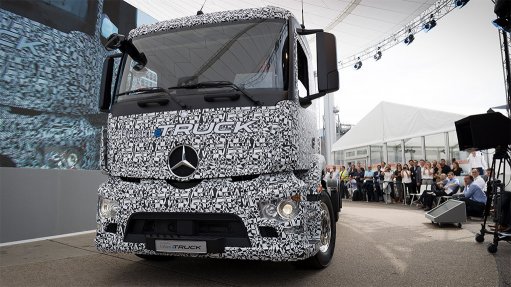
Research firm Frost & Sullivan’s latest analysis of the electric truck market finds that the global light/medium/heavy-duty hybrid and full electric truck segments are expected to reach yearly sales of more than 2.25-million units by 2025.
Frost & Sullivan believes China will lead the electrification of powertrains, contributing 60% of global sales.
Key factors like a policy shift toward electric powertrains, incentive programmes, strengthening emission regulations (especially at urban centers) and rapid technology advancements will augment high sales growth globally, says the Frost & Sullivan report on the matter, ‘Executive Analysis of Electric Truck Market, Forecast to 2025’.
“The case for electric trucks is becoming more compelling with new business models like the leasing of trucks and battery packs or fuel cell stacks, the availability of incentives, as well as subsidies driving market change,” says Frost & Sullivan mobility team leader Chandramowli Kailasam.
“Europe is expected to switch to hybrid or full electric technologies in an active drive towards the European Union’s [EU’s] 20-20-20 target and to fulfill COP21 [the 2015 United Nations climate change conference] promises.
“In North America, however, awareness of hybrid-electric technologies is expected to be lower than natural gas powertrains as limitations in efficiency gains and recharging points impede adoption rates in the short term until 2020.”
The EU’s 20-20-20 target refers to a 20% cut in greenhouse-gas emissions (from 1990 levels), securing 20% of EU energy from renewables and a 20% improvement in energy efficiency.
The Frost & Sullivan report says the strategic imperatives for growth in the electric truck market include developing 250 kW+ ultrafast charging and battery swapping systems to ensure the electric truck’s recharging time is comparable to average diesel filling times; the entry of new players developing electric trucks with a range of more than 300 miles, autonomous driving functionality, and aerodynamically streamlined designs, as well as investment into battery pack manufacturing and vertical integration of the electric drivetrain.
“Full electric trucks in heavy-duty applications are still an ambitious proposition with significant strides required in battery capacity as well as price,” says Kailasam.
“However, despite these challenges, electric trucks will find its place tailor-made for application in areas like refuse collection, yard trucks, urban parcel and delivery services, and regional hauling. Plug-in hybrids and conventional hybrids will also form part of the mix.”